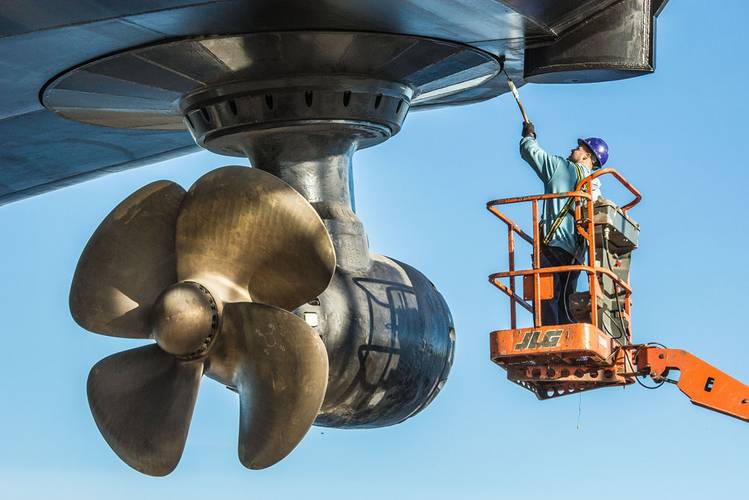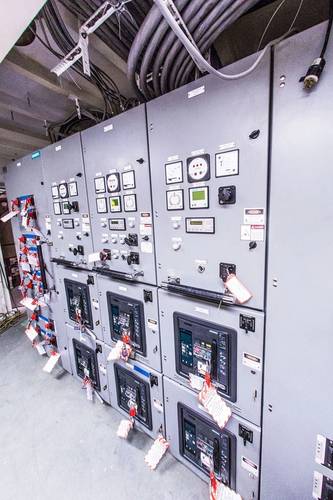RV Sikuliaq: Modern Electric Propulsion & Power Management
While ships have used electricity to help power vessels for a long time, new and sophisticated diesel-electric technologies are making serious gains in efficiency, noise and environmental impact, and is becoming the propulsion system of choice for some high profile names.
A recent case is the diesel-electric powered, RV Sikuliaq (pronounced “see-koo-lee-auk,” an Inupiaq term meaning “young sea ice.”), a vessel embarking on a lifetime of studies in the polar sea region, including examining the effects of climate change and increased human presence in the Arctic.
Sikuliaq is one of the newest addition to the U.S. academic fleet, and the 261-ft.-long vessel will be home for 24 researchers and students who will live and work aboard the ship. It is a Global Class 5 vessel that can conduct research anywhere in the world. It is also designed for research in ice-choked waters. Among its myriad of capabilities are gathering sediment samples from the seafloor, hosting remotely operated vehicles and using instrumentation to study the water column – while having the capability to break through 2.5 ft. of ice.
Its diesel-electric propulsion system ensures the lowest possible environmental impact, including a low underwater radiated noise signature for marine mammal and fisheries studies.
Owned by the National Science Foundation and operated by the University of Alaska Fairbanks (UAF), Sikuliaq was funded by the American Recovery and Reinvestment Act of 2009 (ARRA). The primary coastal facility of the UAF School of Fisheries and Ocean Sciences, the Seward Marine Center is 130 miles south of Anchorage at the head of Resurrection Bay, and is considered its primary base of operation.
Diesel-Electric Vision Comes Together
There is a long-term and never-ending need for research vessels to study the world’s oceans, particularly those able to traverse the treacherous Arctic waters. Through the years, various vessel design options were considered, and in 2004 Glosten Associates came up with the initial design of the Sikuliaq. Even then, the UAF and the architects knew the ship would be powered by a diesel-electric propulsion system because of its mandatory, minimal environmental impact and quiet operation.
At the earliest stages of planning, a state-of-the-art research vessel was envisioned, including the design of the diesel-electric propulsion system, said Siemens Marine Segment Director David Grucza. “We started working on the diesel-electric design in 2004, including one line diagrams, how to handle harmonics, designing the smallest component footprint and applying the equipment,” Grucza said. “Our team in Alpharetta, Ga., helped design the Sikuliaq and execute the project and support startup and commissioning.”
In December 2009, UAF awarded the shipyard contract to Marinette Marine and construction concluded in 2014. Marinette Marine is part of the Fincantieri Marine Group, a subsidiary of Fincantieri, one of Europe’s largest shipbuilders with a history dating back 200 years and a track record of producing more than 7,000 ships. In 2014, the Sikuliaq began its maiden journey from the Wisconsin shipyard, through the Great Lakes-St. Lawrence Seaway transit system, through the Panama Canal and then to Alaska.
Integrated Propulsion System
Allan Pomeroy, Marinette Marine’s senior buyer, has been an integral part of the construction of the ship – beginning with preliminary design, through construction and delivery. He is also responsible for the warranty of the ship. A shipbuilding veteran with 47 years of industry experience, Pomeroy’s responsibility for the Sikuliaq goes from bow to stern, including the Siemens Blue Drive Plus C diesel-electric propulsion system, which was selected to meet the UAF’s tough environmental and performance prerequisites. “Whenever you need a quiet and energy-efficient vessel you go to electric propulsion,” Pomeroy said.
According to Siemens, the Blue Drive system stacks up favorably to alternative drive systems, significantly reducing NOx and greenhouse gases by up to 27%, reducing gas consumption between to 15-23%.
The components of the Blue Drive system include the Simatic PCS 7 monitoring and control system that keeps a watch on power management, as well as more than 4,000 operational points on the ship. Electrical power for the vessel is provided by four diesel generator sets – two MTU 16-cylinder 4000 engines driving 1,850 kW Kato generators, and two MTU 12 cylinder 4000 engines driving 1,380 kW generators. Any can be operated individually or in parallel.
The stern thrusters are ice pod type Z drives supplied by Wärtsilä and the bow thruster is an Elliott Gill water type jet. The Z drive propulsion allows the propeller to swivel 360 degrees horizontally, eliminating the need for a rudder. The port and starboard stern thrusters are each powered by a Siemens 2,875 kW AC motor and a Sinamics S120 variable speed drive (VFD). The bow thruster is powered by a 1,150 kW horsepower Siemens AC motor and another S120 VFD. A 24 pulse configuration on the two main propulsion VFDs eliminates virtually all harmonic distortion by adding a phase shift to the drives’ transformers. This ensures that no dangerous harmonics will affect either the vessel or its sensitive research experiments.
Siemens S7 400 controllers, HMI and four, 690V switchboards take the power from the generators and communicate via hardwire and serial I/O.
Simatic touch panel HMI screens are located on the bridge, galley, captain’s stateroom, chief engineer stateroom, powerhouse, and engineering control room. Step 7 software includes a historian function to accommodate the redundant controller configuration and deliver clear, intuitive information to the crew.
Power Management
The ship’s power management capabilities, an integral part of the Blue Dive / PCS 7 control system, are designed to help keep the Sikuliaq and crew safe while operating in the Arctic environment. “If you lose one of the four generators when you are out to sea, it is not really a big problem,” Pomeroy said. “The power management system ensures the load on each generator is less than 90 percent, but can go up to 110 percent for short periods of time. You cut back your loads to fall within the power that is generated from the other generators. If you lose another one or two, you have to cut your power back in order to stay within the power being generated by the plant because you don’t want your entire plant to go dead,” Pomeroy said.
The Sikuliaq’s power management system monitors the online generator capacity as well as load consumption and automatically cuts back, or cascades, non-essential loads as needed.
“We go through the electrical loads on a ship and we rank them, priority one through 10. The lights in the storeroom are considered a priority 10,” Pomeroy says. “The propulsion system and its auxiliaries are priority ones. Every load on the entire ship is prioritized. If the load is increasing and gets close to the capacity of the generator we knock the circuit breakers off in all the switchboards starting with non-essential priority 10 loads, followed by nine and eight and so on.” Until we reach a safe generating capacity for the machines on-line at that time.
While the breakers are taken offline in a cascading priority, the power management system automatically shuts down the failing generator and starts the standby.
“The Siemens monitoring and control system monitors 250 points on the engines,” Pomeroy says. “In a diesel engine you monitor every piston for temperature, pressure, overheating temperature, temperature of the exhaust and horsepower to make sure that each diesel is putting out the right amount of horsepower. If one piston stops putting out horsepower, we shut the engine down and find out why. That protects the engine. In the middle of the ocean, you don’t want to damage it. You want to fix it.”
As the engine is shut down to prevent damage, the standby is automatically brought online. When it is up and online, and it sees it has a lot of power available, the engineer brings the circuit breakers online beginning with the top priorities and ending with priority 10 loads.
The captain and chief engineer are given enunciations every step of the way through the network of HMIs in the event of a cascading power reduction or any other event monitored by the system.
“Let’s say we shut down the number three engine for low oil pressure, overheating, or loss of fluid. The captain and engineer are informed that the number four, or standby, engine is coming online. Then he is given another announcement that we have tripped off the number 10, nine and eight breakers. He is then informed when the number four engine has come up to speed and is generating the necessary voltage to achieve the proper 60 cycles.”
When the power management system’s load sharing function adjusts the load equally among all three generators, the cascaded circuit breakers that dropped off the switchboards are brought online. At this point, the captain and engineer are notified the condition has returned to normal.
“He is also reminded what started the event in the first place,” Pomeroy says. “If it was low oil pressure in the number three generator he would be notified to check it out.”
Sikuliaq has been approved to Unmanned Engine Room standards because of the automated power monitoring, control and alarming functions supplied by the Blue Drive system.
(As published in the November 2014 edition of Maritime Reporter & Engineering News - http://magazines.marinelink.com/Magazines/MaritimeReporter)


















